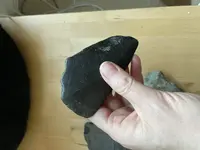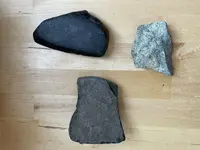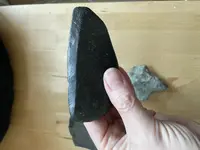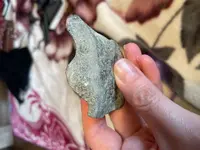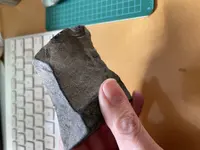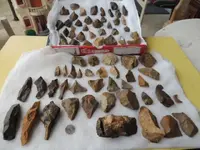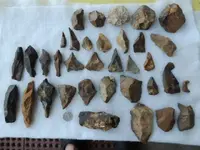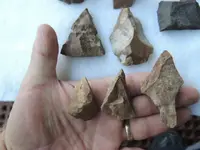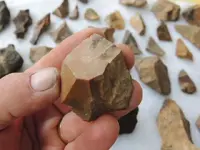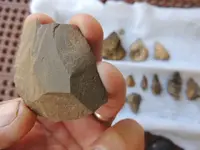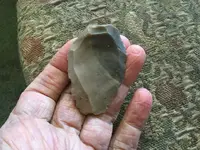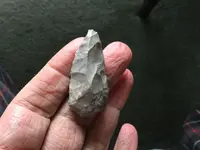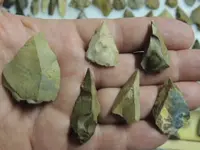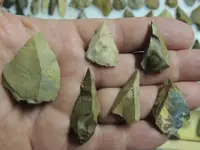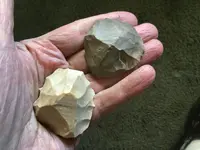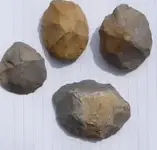This is discouraging.
It's not that people only care about what they like, and don't care about what they don't, because that's just human nature. It's that they paper over the holes in the big picture that result from this selective attention with ideas they imagine are true, but aren't. Like, in years past, that big bifaces were "buffalo points," that artifacts were worked by dripping water on heated flint, and (this one's still an uphill fight) that "soft hammer percussion" was done by using the "antler billets" there's no evidence of in the archaeological record, and not the small punches found everywhere that antler survives in the ground.
Worse, people grow attached to their beliefs. They love them, and are ready to go to war over them like gangs defending their turfs, the same way the Piled-Higher-and-Deepers were over "Clovis first" (until they realized that the people whose respect they valued, peers in other fields who were able to review the evidence and think for themselves, were laughing at them).
That, in my unwelcome view, is the movie that's playing here, and why we're getting nowhere.
I've tested people's patience (and worn myself out) posting information about Levallois industries here in the eastern United States. And it's made no impression. Due, probably, to the combination of several facts: 1) because these artifacts are not pretty the way that nice "arrowheads" can be. 2) because learning to recognise them -- and the thinking patterns that went into their creation -- requires starting from scratch. (People in Europe don't find this difficult. But Europeans have at least what's left of an educational system). And the big one: 3) because the official, virtually mandatory belief is that there were no people of any sort here before, say, 20,000 BC. This survives on its own momentum as a pure, evidence-free belief in the face of conclusive evidence to the contrary like the Hueyatlaco Site in Mexico. It's like the midwestern farmer who was asked by a neighbor whether he now believed there were animals like elephants and giraffes after he had seen them with his own eyes at the state fair? "Ain't no such animals." He knew horses and cows and sheep. And those things didn't fit the pattern of the familiar. The discomfort revising his beliefs involved went against the grain, and simple denial was the easy way around the problem, so denial it was.
If I declared for a fact that I was a competent judge of earth moving machinery because I was an experienced auto mechanic, or that I had a good grasp of western classical music because I played in a heavy metal band, the disconnect between assumption and reality would be obvious to everybody. That it's not here (in fairness, most of it was on the old Arrowheadology board) is not the result of not trying. Two I'm sure I've referenced are
http://pleistocenecoalition.com/newsletter/march-april2015.pdf
http://pleistocenecoalition.com/newsletter/may-june2015.pdf
and discussion at
levallois in the United States - Archaeologica.org
A third I'm pretty sure I've cited is
www.researchgate.net/publication/33...Like_Flaked_Stone_Technology_in_North_America
A couple points in conclusion: dogmatic carrying on about the alleged necessity of "context" is refuted by
John Witthoft having recognised, defined and established the Paleoindian era in 1952
based entirely on the out-of-context artifacts surface collected at the Shoop site. What was needed was not "context" but
the ability to see what he was looking at, and understand what it was.
As far as the Mousterian industry being associated in the public mind with Neanderthals, and those with Europe, might I point out that people who dig for artifacts here are associated in the public mind with tweakers funding their meth addictions ? Or is that taking being a wiseass over the line ? OK then. Sorry. But "I keep those two in separate mental boxes," Levallois and USA, does not mean "those are two separate things." Especially when abundant evidence like Rick Donninger's proves there were hominids of
some sort here* who were making them, and in large quantities -- they didn't make themselves, and the patterns they show repeat so many times, and match European examples so perfectly that claiming otherwise is absurd.
My request in closing:
Don't be that farmer.
________________
* A story I've told before that I don't expect anyone to believe but is nevertheless true: I held the fossilized cranium of an Anthropopithecene of the type Leakey found in East Africa in my hands when I was 17. It had come out of a coal mine in western Virginia.



